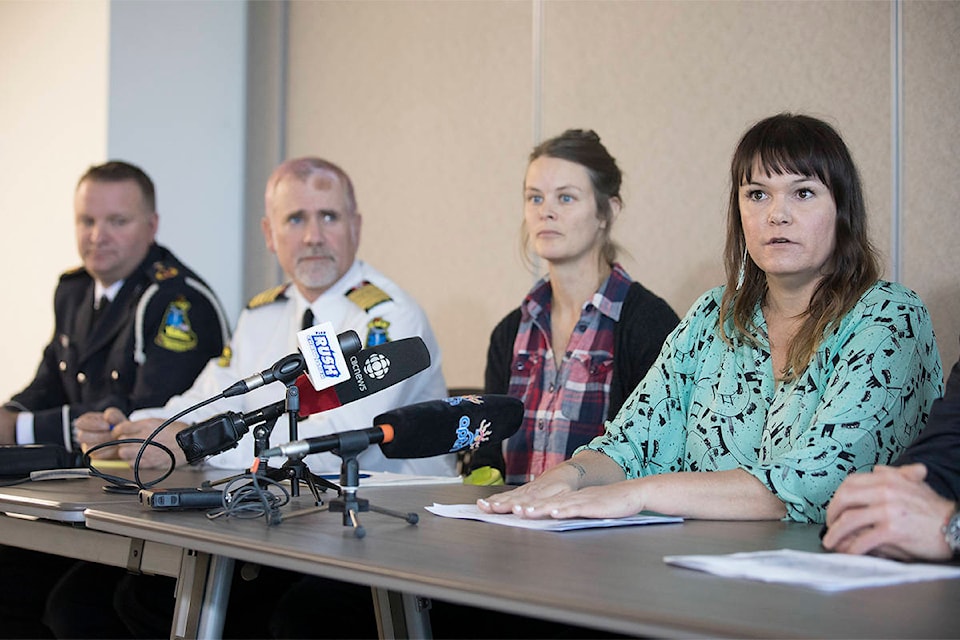A number of changes are underway at the Whitehorse emergency shelter that will see shifts in how the downtown facility is staffed and managed.
Yukon Health and Social Services Minister Pauline Frost announced the initiatives, which include having a paramedic, outreach worker and social worker stationed at the shelter as well as transforming the transitional housing units into permanent housing at a press conference Oct. 28.
“We all know that poverty and homelessness are a real issue and a real problem in our community, and of course Yukon,” Frost told reporters.
While acknowledging that local businesses and families “have expressed growing frustration, anger and even fear over visible social problems that they are experiencing in their neighbourhood,” she emphasized that the shelter and its guests are not the “problem.”
“These are symptoms of real problems in our society,” she said.
“The real problems include poverty, intergenerational trauma, addictions, homelessness and mental health issues. The solution to these issues is complex … That is why the Safe at Home partners are here today, because working alone does not solve the problem.”
The Yukon government took over the shelter from the Salvation Army in January. While it previously had an abstinence policy, the shelter is now a low-barrier facility, and Frost said it’s now seeing about 50 to 60 guests per night compared to the 12 to 15 it was seeing last December.
There are 10 key changes that will take place, or that have already been implemented, at the shelter to address issues.
Among other things, the Department of Justice is coordinating the development of a community safety plan; the RCMP and Department of Health and Social Services will pilot a community liaison officer position; a psychiatric nurse and a mental health counsellor will be working at the shelter; and some shelter staff have been reassigned to focus on delivering and leading programming for shelter users.
The facility’s 20 transitional housing units, originally intended as a stop-gap for people seeking permanent housing, will also be turned into permanent housing for “chronically homeless with very complex health and support needs.”
Christine Tapp, the director of the Yukon government’s social supports branch, said that transition began as soon as the government took over the facility.
“We’ve been doing it as a gradual process over the last several months in terms of finding permanent housing for the individuals who were residing there when we transitioned operations,” she said, adding that “not even a handful” of residents are still in the units.
She said there is no firm date for when the units will become permanent housing.
Tapp also said exterior and interior renovations are planned for the facility, but could not offer any details.
Another change already in place is the stationing of a paramedic at the shelter for nearly 11 hours a day, seven days a week.
Yukon EMS director Gerard Dinn told media that the service had received upwards of 700 calls to the shelter between January and September this year, or about three to five calls a day.
“What we’ve kind of noticed is most of these the calls are based on not receiving primary health care needs, so some ongoing medical treatment, some wound care … A certain amount of these are also associated to altered levels of consciousness that may or may not be associated with a chronic condition or use of street drugs and alcohol,” Dinn said.
The goal of stationing a paramedic at the shelter, Dinn said, is to provide primary and preventative health care for users on-site, with the two paramedics assigned to the position specially trained in advanced wound care and mental health and addiction issues.
“We certainly have seen a reduction in ambulance response to the Whitehorse emergency shelter already,” he said, adding that stationing a paramedic at the shelter will not adversely impact EMS operations in Whitehorse.
Yukon RCMP Insp. Keith MacKinnon said police receive an average of 46 to 48 calls to the shelter area a week, ranging from noise complaints to reports of violence.
The Yukon government was unable to say how much the changes would cost, if anything, something the Yukon Party took the Liberals to task over at the legislative assembly.
“You know, Mr. Speaker, what we are looking for is a dollar figure,” Watson Lake MLA Patty McLeod said in the House after asking Frost how much “new money” had been allocated for the changes.
“It is unfortunate that the minister would make an announcement without knowing how much it will cost,” McLeod continued.
“We’re happy to hear about how these programs will attempt to address concerns and how they will better help those who need the services most, but we do not see a line item in the budget or the supplementary budget to pay for the announcements that the minister made today.”
Community Services Minister John Streicker, for his part, said having a paramedic at the shelter would not incur additional costs.
Frost responded that she was proud that the changes are “bringing to the core and the heart of our city the supports that are needed for the individuals who occupy and utilize the centre.”
“Do you put a price on that?” she said. “Do you put a price on how much it costs to take care of the individuals who have been left and not supported for years and years and years, Mr. Speaker, under the previous leadership?”
Contact Jackie Hong at jackie.hong@yukon-news.com
